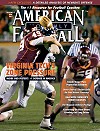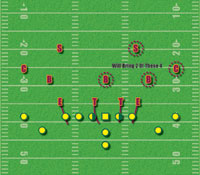AMERICAN FOOTBALL MONTHLY THE #1 RESOURCE FOR FOOTBALL COACHES
Article CategoriesAFM Magazine
|
Zone PressureBud Foster\'s Virginia Tech zone pressure package: leading the nation in total defenseby: Michael Parker © More from this issue Virgina Tech has had tremendous success against teams that run spread-type offenses the last few seasons. In fact, the Hokies are undefeated against offensive-minded teams like Louisville, Clemson, Wake Forest, and West Virginia since 2003. So many teams struggle adapting their old schemes to these new formations without leaving their kids vulnerable to the run game. Or, they give up huge chunks of yardage in the pass game trying to put pressure on the passer and leave their defenders with too much space to cover. Plus, these spread schemes use athletic quarterbacks to make plays where the numbers in the box favor the offense. But recent Frank Broyles award winner Bud Foster has managed to make the opposing quarterback run for his life, not for his stats. The Hokies led all D I-A colleges in total defense last fall. Tech’s Defensive Strategy Foster’s basic strategy is simple. "We are going to stop the run and make you have to pass if you want to score,” he says. “We believe in putting pressure on people,” he adds. “We have run pressures and pass pressures, and we use them, obviously, at different times.” The run pressures are meant to try to bring different people through gaps and make the angle on blocks for the OL more difficult. It is crucial that the gaps are secured and proper precautions are made for the various QB reads that spread offenses employ. Pass pressures are broken up into zone pressures and man pressures. “Zone pressures give us the ability to put pressure on the QB but with less risk.” This makes built-in hot routes and sight adjustments on routes difficult, because the blitzing defender isn’t necessarily the player responsible for the receiver in pass coverage. “We will roll our coverage to the pressure side,” says Foster. “We are a base 4-3 team. A while back we went from more eight man fronts to two high safeties because people schemed us well,” Foster says. “Now we are putting both safeties back about 70% of the time.” While this article details Tech’s zone pressure package, Foster pointed out it is important to have contingency plans to check to in special situations. “When teams go empty, we still want to bring pressure. We aren’t going to just sit back there and let the QB throw the ball.” They use man pressure schemes when there are only five blockers. “That QB is going to have to get rid of the ball fast. Sometimes we do different things with that, like drop a DT. We have even had a few DT's with picks off middle screens the past few years.” Preparing Your Zone Pressure Package For Your Opponent: Planning Foster follows a few methodical steps in preparing for any opponent. “We study protections. We will know from watching the film how teams are going to try to block us up front,” says Foster. Obviously, in spread sets, the potential number of blockers is less than in more traditional sets. It is crucial to know whether teams use man or zone schemes in pass protection and whether they are using the RB in the scheme or not. Foster wants to know which side will have more blockers and bring pressure from the other side. It is important to note that this zone pressure scheme shouldn’t be used randomly. “We break each week down into specific parts of defense that we will focus on each given day,” says Foster. Virginia Tech works on short yardage and goal line situations on Monday. On Tuesday, the focus is on first and second down, including runs, play action passes, and quick screens. Wednesday finishes up the installation with third down and 4+ yards to go, draws, screens, and drop back passes. Foster stresses that it is important to know what teams are capable of and their tendencies so that you can give your players the best chance to succeed. “You need to know when teams usually pass and usually run, and what they usually do out of certain sets. That way you have as good a chance as possible to make the right call,” he says. Practicing Implementation will vary based with your situation, but Tech has a special way of making sure that the team is prepared for the speed and strength of the upcoming opponent. “We practice a lot of good-on-good during the week to really try to prepare the kids. I know that isn’t possible everywhere, but it can really make a difference if you have enough guys to do it,” he says. Also, during the week’s practices, each of the defensive coaches focus on ensuring that the defensive scheme is structurally sound and that coverages and audibles are carefully thought out and gone over so blitzing defenders don’t leave major weaknesses in coverage behind them. “Just because you are planning to sack the QB doesn’t mean you don’t have to worry about the coverages,” says Foster. Tech’s Alignment vs. Shotgun Spread Formations Foster thinks that teams shouldn’t change who they are too much from week to week. He feels you lose strength in your scheme when you try to do things that you haven’t done before. Another aspect that Foster feels is important is that no matter what front his defense lines up in, the terminology stays the same. This helps the players understand in greater detail what is going on regardless of how they are aligned. To go along with his philosophy to stop the run, Foster structures the defense to drive teams away from the shortest distance between the line of scrimmage and end zone. “The defense is designed to force the offense to the outside,” he says. In this way, Foster can dictate to the opposing offense that they will have to play to the Hokies’ strength – pursuit and quickness. And over the past decade or so, the Hokies have had plenty of both. Now, in typical spread sets, either 2x2 or 3x1 with one RB and no TE, Tech lines up in a base quarters coverage look. “But we don’t dictate coverage by alignment.” The OLBs on each side line up in what Foster calls the ‘apex’ between the slot receiver and the OT (See Diagram 1). “Basically, we tell them to have good run leverage and good coverage leverage. They have to play both, so they line up somewhere near the middle where they feel they can stop the run game and drop into pass coverage.” Or rush the passer.
The DEs play outside shade on the OTs. The DTs play in a classic 3 tech and 1 tech (which is called a 2 tech at Virginia Tech) alignment depending on where the offensive strength is declared. That might vary from week to week based on the offensive scheme. The strength is determined by the number of wide receivers to a side, boundary vs. field, and which side the running back is on. “When teams come out in Empty, we have a ‘Check With Me’ that we call. That is all schemed during the week and it will depend on what the offense does out of Empty,” says Foster. Carrying Out The Plan Tech’s basic zone pressure package brings six players – four from one side. With the C as the middle of either side of the line, that means that each side can have at most four blockers, including the C, G, T, and RB on either side. By bringing six defenders, and four to a side, that means that every potential blocker will have to pick up a man – and block him. In coverage, you still have five defenders. Tech’s coverages vary based on the opponent. Teams that run horizontal stretch schemes need to be covered differently than teams that run vertical stretch schemes. But, the basic principles remain the same. The defenders still drop to certain areas on the field and find their respective pass receiver key. Foster explains that he will bring different players at different times depending on field position, hash, offensive personnel, down and distance. In the past, the Hokie’s have been well known for their boundary blitzes using their boundary corner. “The War Daddy,” as Foster calls him. “We will either bring a LB and the safety, or the CB and the LB, or two LBs from the same side, but we will bring two,” he says. He will also vary where they come, and uses stunts and slants to make it difficult to find and pick up blitzing defenders. They might stunt the DE, and bring two defenders through the same gap, or bring them through different gaps (See Diagram 2).
“We want to bring the players from depth as much as possible. It makes it impossible for the offensive players to recognize who is coming before the snap,” says Foster. This makes it difficult for QBs and the OL to make protection checks and/or WRs to make sight adjustments. Tech’s zone pressure package is well-suited to any level of football. It is simple enough to implement, but difficult for opposing offenses to prepare for. It allows defenses the ability to bring pressure without putting their coverage defenders in a man-to-man situation. |
|
| HOME |
MAGAZINE |
SUBSCRIBE | ONLINE COLUMNISTS | COACHING VIDEOS |
Copyright 2024, AmericanFootballMonthly.com
All Rights Reserved






